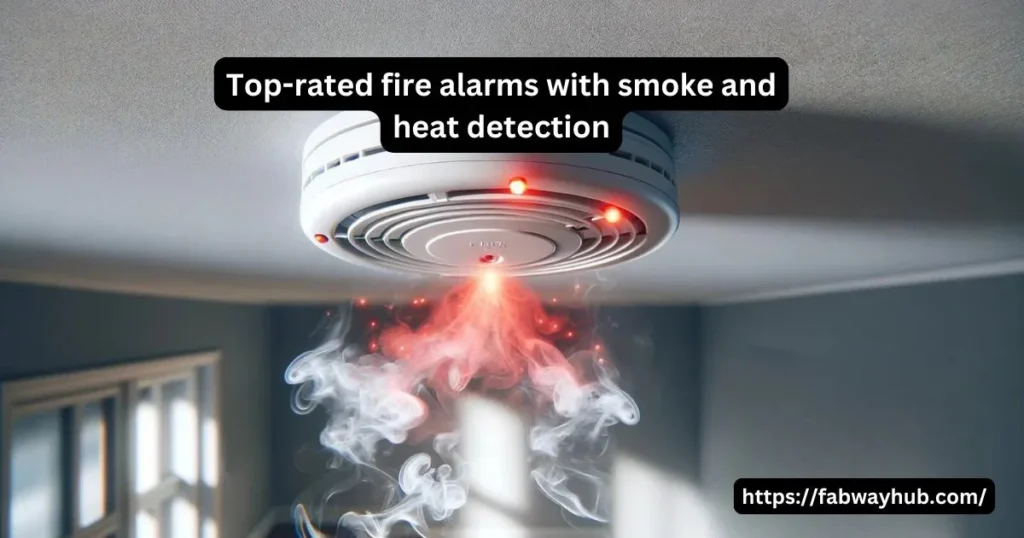Introduction:
Then fire safety is something you will absolutely not tolerate when it comes to your family and home safety. A proper fire alarm could save your life (or your house). In this article, we will go through the best fire alarms with smoke and heat detection capabilities. And everything else you need to know, from key features to the best brands, in order to make an informed decision.
Table of Contents
The Role of Fire Alarms in a Contemporary Residence
Fire alarms are the foundation of home safety. Statistics show approximately 60 percent of fire deaths take place in homes without a working alarm. Early detection is the name of the game, and that’s exactly what fire alarms do best. By spotting potential dangers before they spiral out of control, they offer critical time to evacuate and get emergency services involved.

The Critical Combination of Smoke and Heat Detection
Most alarms include smoke detection as standard, but adding heat detection provides an additional safety measure. Smoke detectors detect airborne particles, while heat sensors trigger when the temperature gets too high. While smoldering is detected, the flaming hazard is dealt with, providing a multi-layered fire protection solution.
Important Fire Alarm Features
Fire Detection Technology
Smoke detection forms the key component of any fire alarm system. There are two main types of sensors in modern alarms:
- Ionization Sensors: Suitable for fast-flaming fire detection.
- Photoelectric Sensors: More sensitive to smoldering fires.
Applications of AI Generative AI systemsSome of the more advanced models combine both technologies to produce superior performance.
Sensitivity to Heat Detection
Heat sensors are important for places where smoke detectors could trigger false alarms, like kitchens or garages. These sensors will sound an alarm once temperatures reach a set threshold, usually 135°F to 165°F.
Smart Home System Integration
This is where smart fire alarms elevate safety. They link to your home’s Wi-Fi network, and send alerts to your phone or other devices. Brands such as Nest Protect seamlessly integrate with systems like Google Home or Amazon Alexa.
Battery and Power Backup
We need a dependable source of power. Many alarms have long-life lithium batteries that can last as long as 10 years. For extra protection during a power outage, some models also feature hardwiring options with battery backup.
Best Brands to Consider for Fire Alarms
Nest Protect
Nest Protect: smart fire alarm with a reputation This pairs smoke and heat detection with carbon monoxide monitoring. Voice alerts and app notifications are among the features that have made it popular with tech-savvy homeowners.
First Alert
First Alert tools are known for their reliability. The dual-sensor alarms feature both ionization and photoelectric technologies for comprehensive fire detection.
Kidde FireX
Kidde’s line of alarms tends toward affordability and practicality. They do have models available that feature smoke and heat detection, ideal for home use (FireX series).
X-Sense
Under is the prime difference between the two through latest technology. X-Sense is known for its elegant design and high-performance. Many of their alarms have a 10-year battery and can connect to one another to provide coverage of your entire home.
Top Fire Alarms for Your Needs
For Small Homes
For tight spots, alarms like the Kidde FireX 21006378 provide stellar performance at a wallet-friendly price. Their scaled-down design means they won’t take over your ceiling.
For Large Properties
Do you have interconnected alarms in large homes? In systems such as the X-Sense Wireless Interconnected Alarms, all units will sound off together, ensuring maximal coverage.
For Apartments
Apartment dwellers should look at compact yet effective alarms like the Nest Protect, which provide smart alerts even when you’re out.
Budget-Friendly Options
First Alert has a few inexpensive options that deliver without scrimping on quality. The SA320CN, for example, pairs up dual sensors with an affordable price.

Fire Alarms: Installation and Maintenance
Effectiveness of Proper Placement
You need to pay attention to placement for fire alarms to perform effectively. Keep alarms in each bedroom, outside sleeping areas and on each level of your home, including the basement.
Regular Maintenance Tips
- Test alarms monthly.
- Change batteries once a year unless you use a long-life battery model.
- Prevent False Alarms: Keep units clean and free from dust.
How Often to Change Your Fire Alarm
Fire alarms generally have a lifespan of between 7-10 years. Inspect the manufacture date and update outdated units to maintain proper safety.
Advantages to Purchase Premium Fire Alarms
More Safety for Families
- Fire alarms are lifesavers by providing early warnings, giving families precious time to escape.
Avoiding Property Damage
- The sooner a fire is detected, the less damage it will cause and the more likely it is to save thousands of dollars in repairs.
Insurance Benefits
- This most often leads to reduced premiums and therefore lower costs for homeowners, with many insurance providers offering discounts for homes with properly functioning and regularly serviced fire alarms.
FAQs:
How Frequently to Test Your Fire Alarms
Once a month, test the alarms to ensure they’re working properly.
Can Fire Alarms Also Detect Carbon Monoxide?
Some more advanced units, such as Nest Protect, also have dual functionality for carbon monoxide detection as well.
How Long Does a Fire Alarm Last?
Most alarms last 7-10 years. Look for a manufacture date on your device.
Do Fire Alarms Operate In The Absence Of Power?
Yes, models with battery backups will continue to function during power failures.
Specialized Commercial Fire Alarms: Is There Such a Thing?
Commercial warning systems are on the market and may include features such as strobe lights and interconnectivity to meet regulatory requirements.